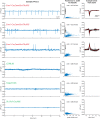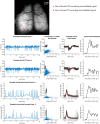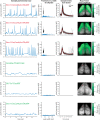Aberrant Cortical Activity in Multiple GCaMP6-Expressing Transgenic Mouse Lines
- PMID: 28932809
- PMCID: PMC5604087
- DOI: 10.1523/ENEURO.0207-17.2017
Aberrant Cortical Activity in Multiple GCaMP6-Expressing Transgenic Mouse Lines
Abstract
Transgenic mouse lines are invaluable tools for neuroscience but, as with any technique, care must be taken to ensure that the tool itself does not unduly affect the system under study. Here we report aberrant electrical activity, similar to interictal spikes, and accompanying fluorescence events in some genotypes of transgenic mice expressing GCaMP6 genetically encoded calcium sensors. These epileptiform events have been observed particularly, but not exclusively, in mice with Emx1-Cre and Ai93 transgenes, of either sex, across multiple laboratories. The events occur at >0.1 Hz, are very large in amplitude (>1.0 mV local field potentials, >10% df/f widefield imaging signals), and typically cover large regions of cortex. Many properties of neuronal responses and behavior seem normal despite these events, although rare subjects exhibit overt generalized seizures. The underlying mechanisms of this phenomenon remain unclear, but we speculate about possible causes on the basis of diverse observations. We encourage researchers to be aware of these activity patterns while interpreting neuronal recordings from affected mouse lines and when considering which lines to study.
Keywords: Cortex; GCaMP; epilepsy; transgenic.
Conflict of interest statement
Authors report no conflict of interest.
Figures






Similar articles
-
Short-Term Memory Impairment.2024 Jun 8. In: StatPearls [Internet]. Treasure Island (FL): StatPearls Publishing; 2025 Jan–. 2024 Jun 8. In: StatPearls [Internet]. Treasure Island (FL): StatPearls Publishing; 2025 Jan–. PMID: 31424720 Free Books & Documents.
-
The Black Book of Psychotropic Dosing and Monitoring.Psychopharmacol Bull. 2024 Jul 8;54(3):8-59. Psychopharmacol Bull. 2024. PMID: 38993656 Free PMC article. Review.
-
Idiopathic (Genetic) Generalized Epilepsy.2024 Feb 12. In: StatPearls [Internet]. Treasure Island (FL): StatPearls Publishing; 2025 Jan–. 2024 Feb 12. In: StatPearls [Internet]. Treasure Island (FL): StatPearls Publishing; 2025 Jan–. PMID: 31536218 Free Books & Documents.
-
A CRISPR toolbox for generating intersectional genetic mouse models for functional, molecular, and anatomical circuit mapping.BMC Biol. 2022 Jan 28;20(1):28. doi: 10.1186/s12915-022-01227-0. BMC Biol. 2022. PMID: 35086530 Free PMC article.
-
Surgery for epilepsy.Cochrane Database Syst Rev. 2015 Jul 1;(7):CD010541. doi: 10.1002/14651858.CD010541.pub2. Cochrane Database Syst Rev. 2015. Update in: Cochrane Database Syst Rev. 2019 Jun 25;6:CD010541. doi: 10.1002/14651858.CD010541.pub3. PMID: 26130264 Updated.
Cited by
-
Wide-field imaging in behaving mice as a tool to study cognitive function.Neurophotonics. 2024 Jul;11(3):033404. doi: 10.1117/1.NPh.11.3.033404. Epub 2024 Feb 19. Neurophotonics. 2024. PMID: 38384657 Free PMC article. Review.
-
Optimizing Calcium Detection Methods in Animal Systems: A Sandbox for Synthetic Biology.Biomolecules. 2021 Feb 24;11(3):343. doi: 10.3390/biom11030343. Biomolecules. 2021. PMID: 33668387 Free PMC article. Review.
-
Chronic Ca2+ imaging of cortical neurons with long-term expression of GCaMP-X.Elife. 2022 Oct 5;11:e76691. doi: 10.7554/eLife.76691. Elife. 2022. PMID: 36196992 Free PMC article.
-
Peeking into the sleeping brain: Using in vivo imaging in rodents to understand the relationship between sleep and cognition.J Neurosci Methods. 2019 Mar 15;316:71-82. doi: 10.1016/j.jneumeth.2018.09.011. Epub 2018 Sep 9. J Neurosci Methods. 2019. PMID: 30208306 Free PMC article. Review.
-
Advantages, Pitfalls, and Developments of All Optical Interrogation Strategies of Microcircuits in vivo.Front Neurosci. 2022 Jun 28;16:859803. doi: 10.3389/fnins.2022.859803. eCollection 2022. Front Neurosci. 2022. PMID: 35837124 Free PMC article. Review.
References
Publication types
MeSH terms
Substances
Grants and funding
LinkOut - more resources
Full Text Sources
Other Literature Sources
Medical
Molecular Biology Databases
Miscellaneous
